Case Study: Price Relationship with Organic Food Purchase at Morrisons
VerifiedAdded on 2020/06/06
|41
|11344
|171
Report
AI Summary
This report assesses the relationship between the purchase price and the type of organic food, focusing on customer decision-making at Morrisons Queensbury. The study employs both primary and secondary research methods, including a survey of 50 customers and a review of books, journals, and articles. The research aims to explore the impact of price on consumer buying behavior, specifically regarding organic fruits. Key areas of investigation include the prices of organic fruit at Morrisons Queensbury, the reasons behind customer purchases, and the overall influence of price on purchasing decisions. The literature review explores consumer behavior towards organic food consumption and the link between purchase price and organic fruits. The methodology outlines the research philosophy, approach, design, data collection, and analysis methods. The findings and discussion chapters delve into the collected data and offer insights into the relationship between price and consumer behavior. The report concludes with recommendations for the retail sector and analysts seeking to understand the impact of price on consumer decisions. The report highlights the growing demand for organic food, driven by increased health consciousness and a desire for healthier lifestyles, while also acknowledging the influence of price as a significant factor in consumer choices.
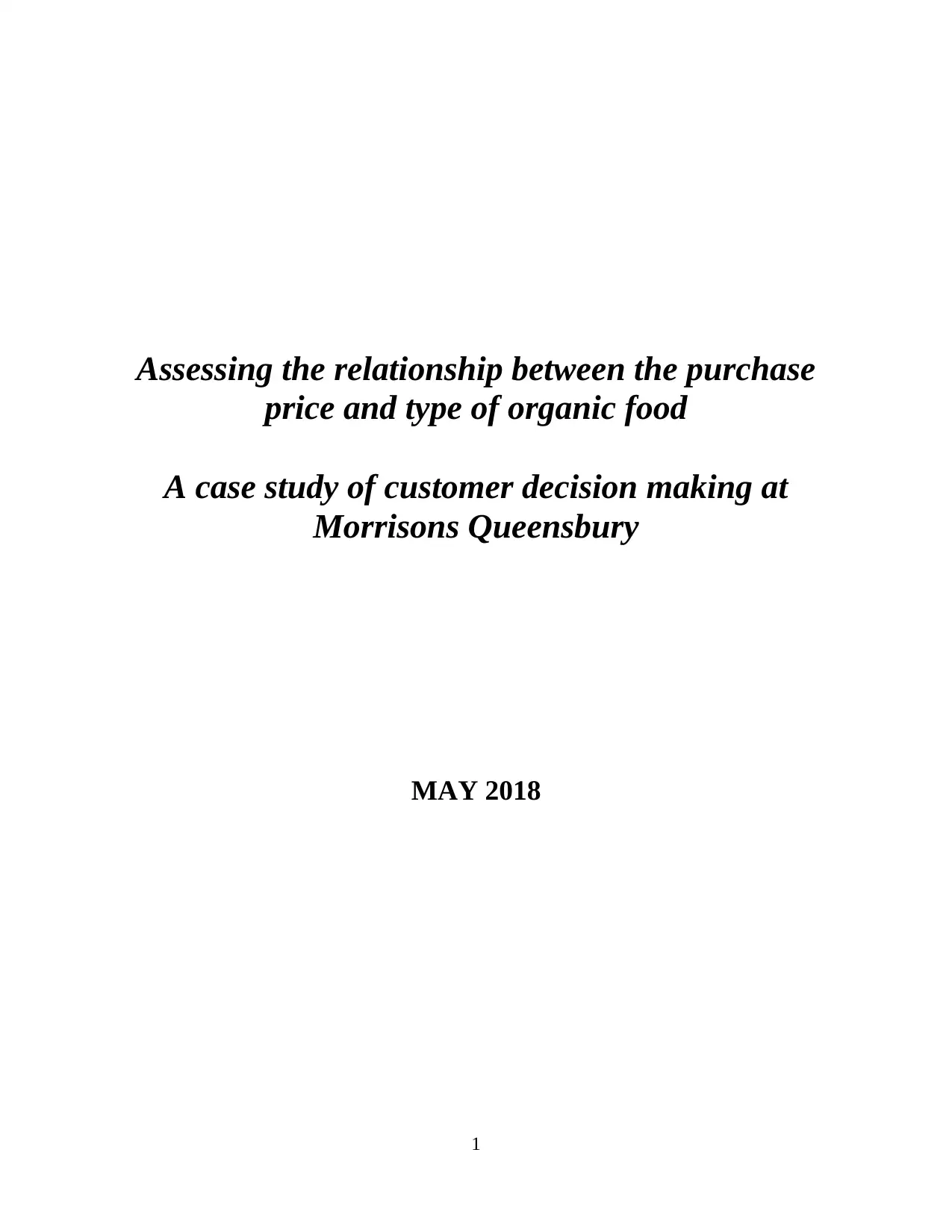
Assessing the relationship between the purchase
price and type of organic food
A case study of customer decision making at
Morrisons Queensbury
MAY 2018
1
price and type of organic food
A case study of customer decision making at
Morrisons Queensbury
MAY 2018
1
Paraphrase This Document
Need a fresh take? Get an instant paraphrase of this document with our AI Paraphraser
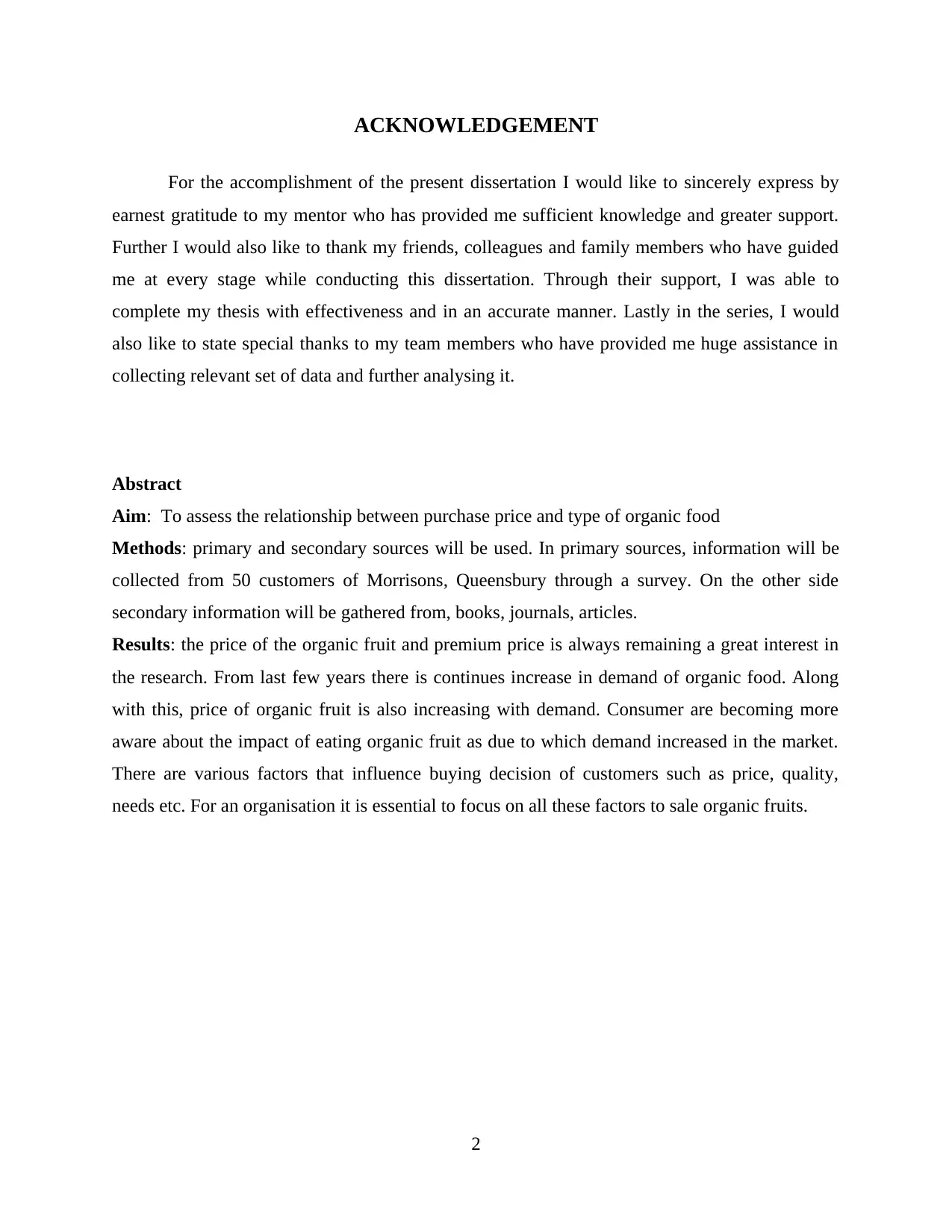
ACKNOWLEDGEMENT
For the accomplishment of the present dissertation I would like to sincerely express by
earnest gratitude to my mentor who has provided me sufficient knowledge and greater support.
Further I would also like to thank my friends, colleagues and family members who have guided
me at every stage while conducting this dissertation. Through their support, I was able to
complete my thesis with effectiveness and in an accurate manner. Lastly in the series, I would
also like to state special thanks to my team members who have provided me huge assistance in
collecting relevant set of data and further analysing it.
Abstract
Aim: To assess the relationship between purchase price and type of organic food
Methods: primary and secondary sources will be used. In primary sources, information will be
collected from 50 customers of Morrisons, Queensbury through a survey. On the other side
secondary information will be gathered from, books, journals, articles.
Results: the price of the organic fruit and premium price is always remaining a great interest in
the research. From last few years there is continues increase in demand of organic food. Along
with this, price of organic fruit is also increasing with demand. Consumer are becoming more
aware about the impact of eating organic fruit as due to which demand increased in the market.
There are various factors that influence buying decision of customers such as price, quality,
needs etc. For an organisation it is essential to focus on all these factors to sale organic fruits.
2
For the accomplishment of the present dissertation I would like to sincerely express by
earnest gratitude to my mentor who has provided me sufficient knowledge and greater support.
Further I would also like to thank my friends, colleagues and family members who have guided
me at every stage while conducting this dissertation. Through their support, I was able to
complete my thesis with effectiveness and in an accurate manner. Lastly in the series, I would
also like to state special thanks to my team members who have provided me huge assistance in
collecting relevant set of data and further analysing it.
Abstract
Aim: To assess the relationship between purchase price and type of organic food
Methods: primary and secondary sources will be used. In primary sources, information will be
collected from 50 customers of Morrisons, Queensbury through a survey. On the other side
secondary information will be gathered from, books, journals, articles.
Results: the price of the organic fruit and premium price is always remaining a great interest in
the research. From last few years there is continues increase in demand of organic food. Along
with this, price of organic fruit is also increasing with demand. Consumer are becoming more
aware about the impact of eating organic fruit as due to which demand increased in the market.
There are various factors that influence buying decision of customers such as price, quality,
needs etc. For an organisation it is essential to focus on all these factors to sale organic fruits.
2
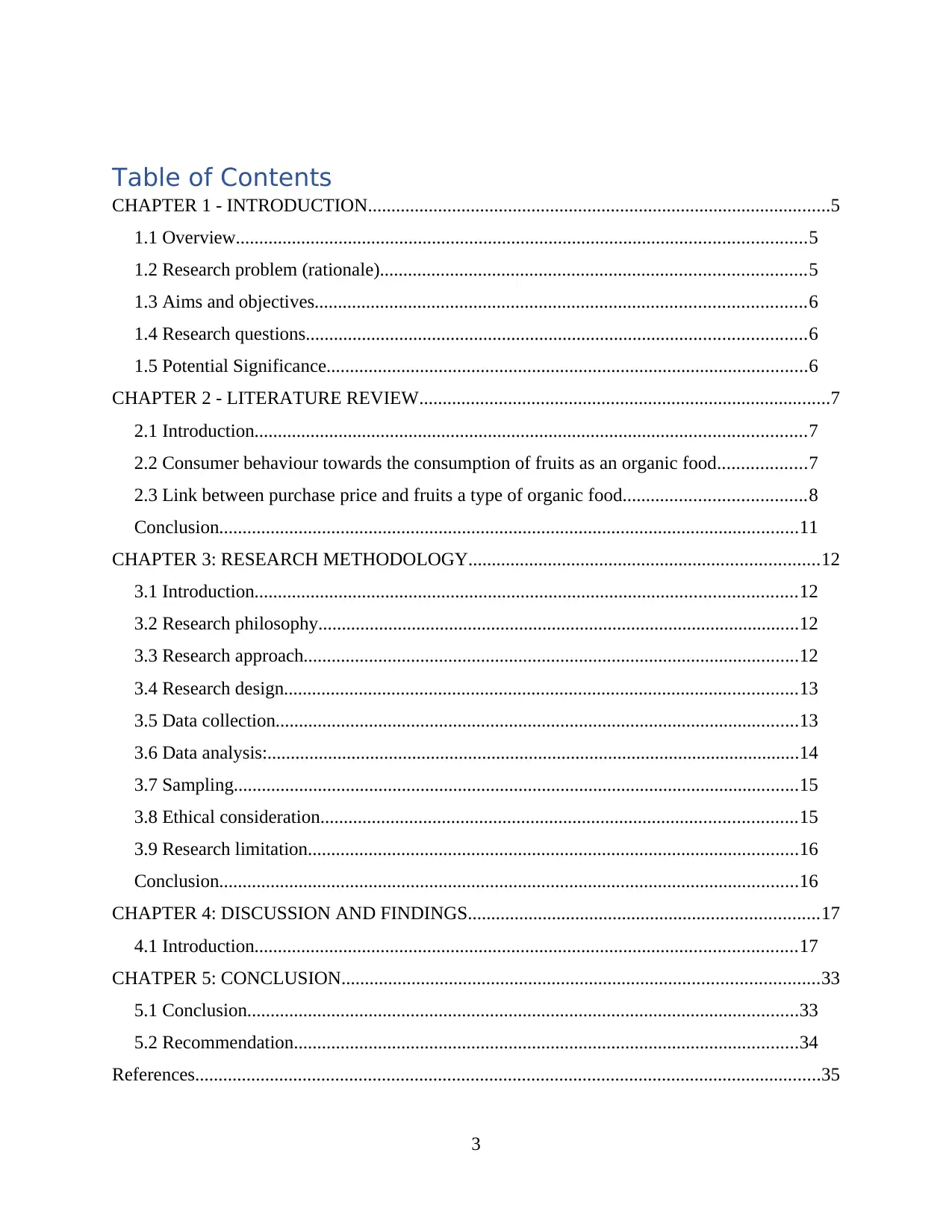
Table of Contents
CHAPTER 1 - INTRODUCTION...................................................................................................5
1.1 Overview..........................................................................................................................5
1.2 Research problem (rationale)...........................................................................................5
1.3 Aims and objectives.........................................................................................................6
1.4 Research questions...........................................................................................................6
1.5 Potential Significance.......................................................................................................6
CHAPTER 2 - LITERATURE REVIEW........................................................................................7
2.1 Introduction......................................................................................................................7
2.2 Consumer behaviour towards the consumption of fruits as an organic food...................7
2.3 Link between purchase price and fruits a type of organic food.......................................8
Conclusion............................................................................................................................11
CHAPTER 3: RESEARCH METHODOLOGY...........................................................................12
3.1 Introduction....................................................................................................................12
3.2 Research philosophy.......................................................................................................12
3.3 Research approach..........................................................................................................12
3.4 Research design..............................................................................................................13
3.5 Data collection................................................................................................................13
3.6 Data analysis:..................................................................................................................14
3.7 Sampling.........................................................................................................................15
3.8 Ethical consideration......................................................................................................15
3.9 Research limitation.........................................................................................................16
Conclusion............................................................................................................................16
CHAPTER 4: DISCUSSION AND FINDINGS...........................................................................17
4.1 Introduction....................................................................................................................17
CHATPER 5: CONCLUSION......................................................................................................33
5.1 Conclusion......................................................................................................................33
5.2 Recommendation............................................................................................................34
References......................................................................................................................................35
3
CHAPTER 1 - INTRODUCTION...................................................................................................5
1.1 Overview..........................................................................................................................5
1.2 Research problem (rationale)...........................................................................................5
1.3 Aims and objectives.........................................................................................................6
1.4 Research questions...........................................................................................................6
1.5 Potential Significance.......................................................................................................6
CHAPTER 2 - LITERATURE REVIEW........................................................................................7
2.1 Introduction......................................................................................................................7
2.2 Consumer behaviour towards the consumption of fruits as an organic food...................7
2.3 Link between purchase price and fruits a type of organic food.......................................8
Conclusion............................................................................................................................11
CHAPTER 3: RESEARCH METHODOLOGY...........................................................................12
3.1 Introduction....................................................................................................................12
3.2 Research philosophy.......................................................................................................12
3.3 Research approach..........................................................................................................12
3.4 Research design..............................................................................................................13
3.5 Data collection................................................................................................................13
3.6 Data analysis:..................................................................................................................14
3.7 Sampling.........................................................................................................................15
3.8 Ethical consideration......................................................................................................15
3.9 Research limitation.........................................................................................................16
Conclusion............................................................................................................................16
CHAPTER 4: DISCUSSION AND FINDINGS...........................................................................17
4.1 Introduction....................................................................................................................17
CHATPER 5: CONCLUSION......................................................................................................33
5.1 Conclusion......................................................................................................................33
5.2 Recommendation............................................................................................................34
References......................................................................................................................................35
3
⊘ This is a preview!⊘
Do you want full access?
Subscribe today to unlock all pages.

Trusted by 1+ million students worldwide
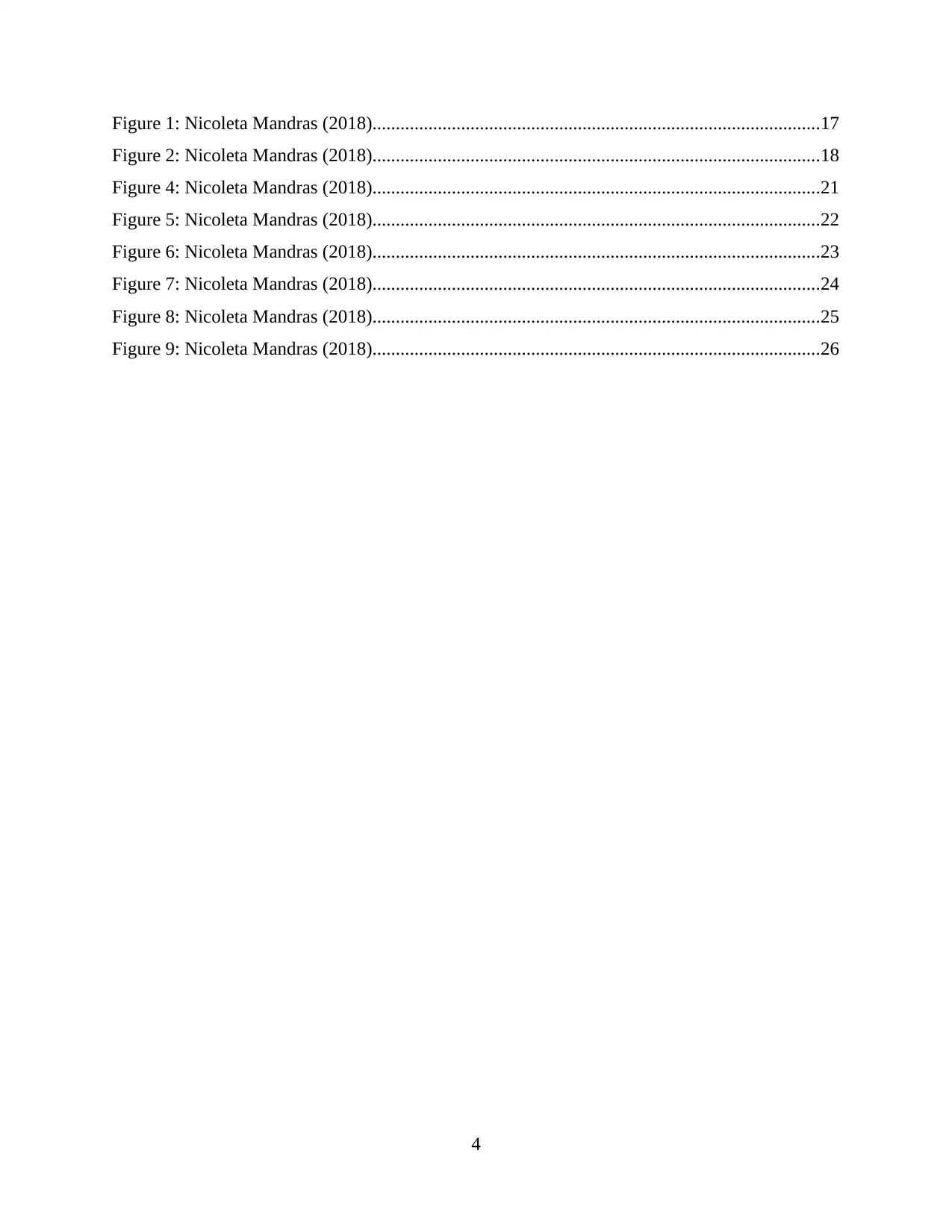
Figure 1: Nicoleta Mandras (2018)................................................................................................17
Figure 2: Nicoleta Mandras (2018)................................................................................................18
Figure 4: Nicoleta Mandras (2018)................................................................................................21
Figure 5: Nicoleta Mandras (2018)................................................................................................22
Figure 6: Nicoleta Mandras (2018)................................................................................................23
Figure 7: Nicoleta Mandras (2018)................................................................................................24
Figure 8: Nicoleta Mandras (2018)................................................................................................25
Figure 9: Nicoleta Mandras (2018)................................................................................................26
4
Figure 2: Nicoleta Mandras (2018)................................................................................................18
Figure 4: Nicoleta Mandras (2018)................................................................................................21
Figure 5: Nicoleta Mandras (2018)................................................................................................22
Figure 6: Nicoleta Mandras (2018)................................................................................................23
Figure 7: Nicoleta Mandras (2018)................................................................................................24
Figure 8: Nicoleta Mandras (2018)................................................................................................25
Figure 9: Nicoleta Mandras (2018)................................................................................................26
4
Paraphrase This Document
Need a fresh take? Get an instant paraphrase of this document with our AI Paraphraser
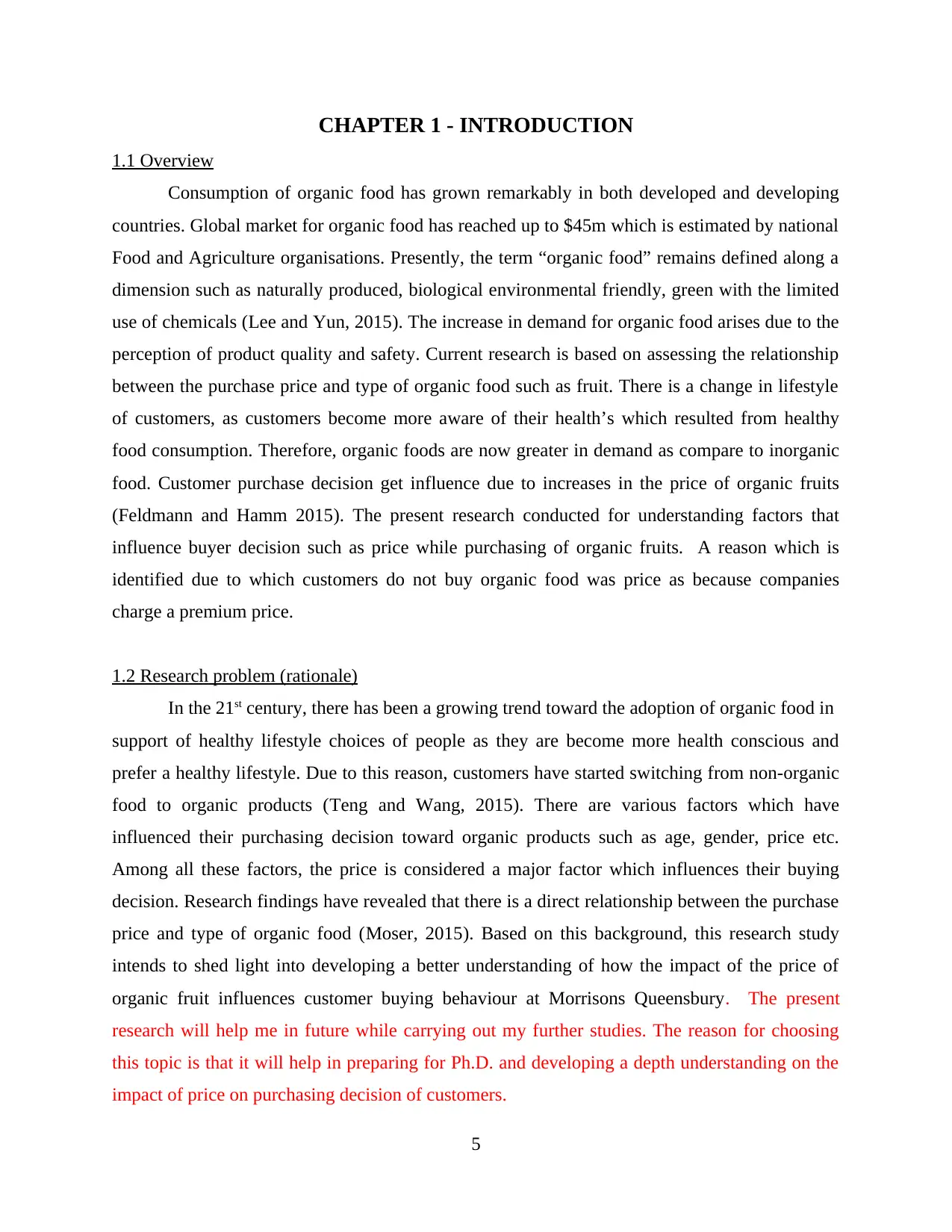
CHAPTER 1 - INTRODUCTION
1.1 Overview
Consumption of organic food has grown remarkably in both developed and developing
countries. Global market for organic food has reached up to $45m which is estimated by national
Food and Agriculture organisations. Presently, the term “organic food” remains defined along a
dimension such as naturally produced, biological environmental friendly, green with the limited
use of chemicals (Lee and Yun, 2015). The increase in demand for organic food arises due to the
perception of product quality and safety. Current research is based on assessing the relationship
between the purchase price and type of organic food such as fruit. There is a change in lifestyle
of customers, as customers become more aware of their health’s which resulted from healthy
food consumption. Therefore, organic foods are now greater in demand as compare to inorganic
food. Customer purchase decision get influence due to increases in the price of organic fruits
(Feldmann and Hamm 2015). The present research conducted for understanding factors that
influence buyer decision such as price while purchasing of organic fruits. A reason which is
identified due to which customers do not buy organic food was price as because companies
charge a premium price.
1.2 Research problem (rationale)
In the 21st century, there has been a growing trend toward the adoption of organic food in
support of healthy lifestyle choices of people as they are become more health conscious and
prefer a healthy lifestyle. Due to this reason, customers have started switching from non-organic
food to organic products (Teng and Wang, 2015). There are various factors which have
influenced their purchasing decision toward organic products such as age, gender, price etc.
Among all these factors, the price is considered a major factor which influences their buying
decision. Research findings have revealed that there is a direct relationship between the purchase
price and type of organic food (Moser, 2015). Based on this background, this research study
intends to shed light into developing a better understanding of how the impact of the price of
organic fruit influences customer buying behaviour at Morrisons Queensbury. The present
research will help me in future while carrying out my further studies. The reason for choosing
this topic is that it will help in preparing for Ph.D. and developing a depth understanding on the
impact of price on purchasing decision of customers.
5
1.1 Overview
Consumption of organic food has grown remarkably in both developed and developing
countries. Global market for organic food has reached up to $45m which is estimated by national
Food and Agriculture organisations. Presently, the term “organic food” remains defined along a
dimension such as naturally produced, biological environmental friendly, green with the limited
use of chemicals (Lee and Yun, 2015). The increase in demand for organic food arises due to the
perception of product quality and safety. Current research is based on assessing the relationship
between the purchase price and type of organic food such as fruit. There is a change in lifestyle
of customers, as customers become more aware of their health’s which resulted from healthy
food consumption. Therefore, organic foods are now greater in demand as compare to inorganic
food. Customer purchase decision get influence due to increases in the price of organic fruits
(Feldmann and Hamm 2015). The present research conducted for understanding factors that
influence buyer decision such as price while purchasing of organic fruits. A reason which is
identified due to which customers do not buy organic food was price as because companies
charge a premium price.
1.2 Research problem (rationale)
In the 21st century, there has been a growing trend toward the adoption of organic food in
support of healthy lifestyle choices of people as they are become more health conscious and
prefer a healthy lifestyle. Due to this reason, customers have started switching from non-organic
food to organic products (Teng and Wang, 2015). There are various factors which have
influenced their purchasing decision toward organic products such as age, gender, price etc.
Among all these factors, the price is considered a major factor which influences their buying
decision. Research findings have revealed that there is a direct relationship between the purchase
price and type of organic food (Moser, 2015). Based on this background, this research study
intends to shed light into developing a better understanding of how the impact of the price of
organic fruit influences customer buying behaviour at Morrisons Queensbury. The present
research will help me in future while carrying out my further studies. The reason for choosing
this topic is that it will help in preparing for Ph.D. and developing a depth understanding on the
impact of price on purchasing decision of customers.
5
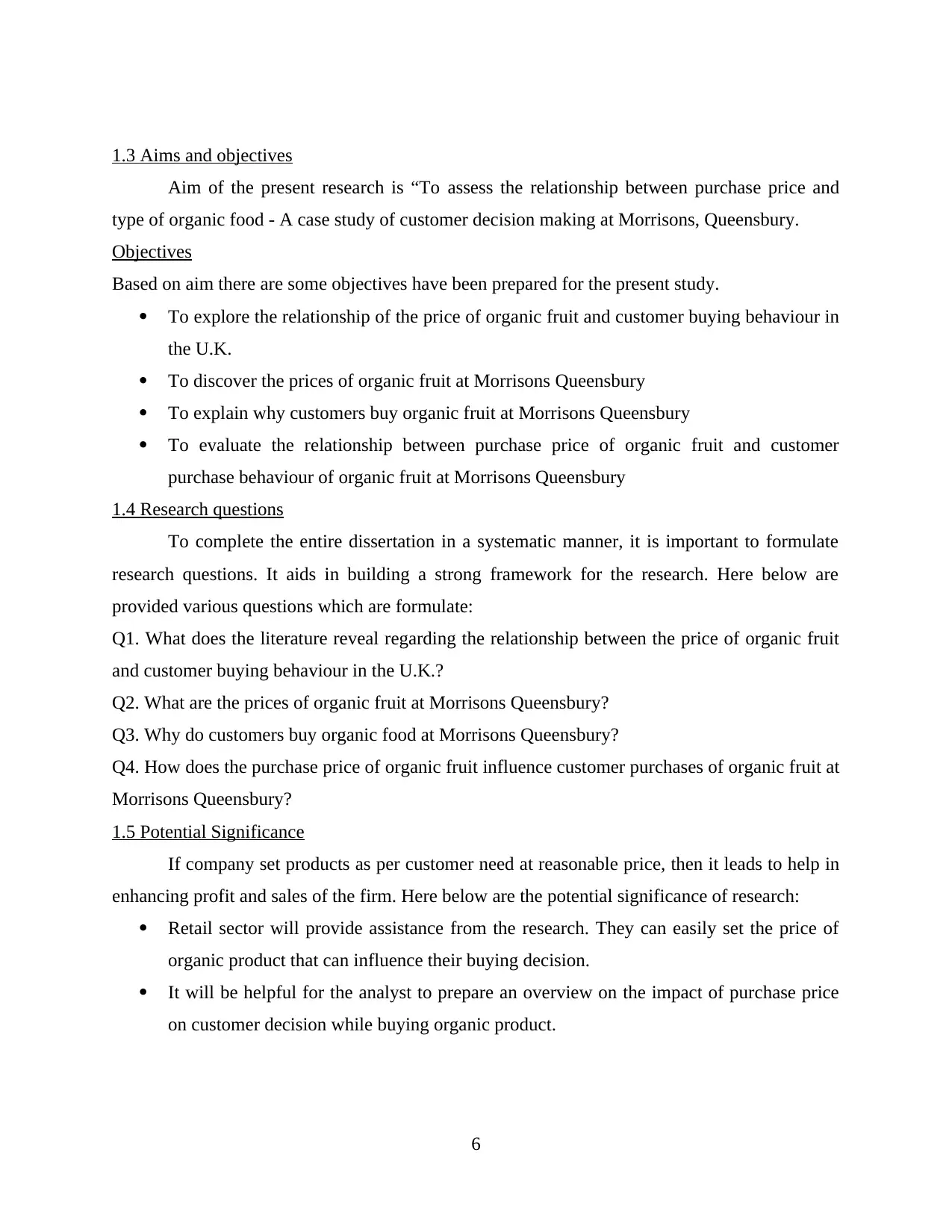
1.3 Aims and objectives
Aim of the present research is “To assess the relationship between purchase price and
type of organic food - A case study of customer decision making at Morrisons, Queensbury.
Objectives
Based on aim there are some objectives have been prepared for the present study.
To explore the relationship of the price of organic fruit and customer buying behaviour in
the U.K.
To discover the prices of organic fruit at Morrisons Queensbury
To explain why customers buy organic fruit at Morrisons Queensbury
To evaluate the relationship between purchase price of organic fruit and customer
purchase behaviour of organic fruit at Morrisons Queensbury
1.4 Research questions
To complete the entire dissertation in a systematic manner, it is important to formulate
research questions. It aids in building a strong framework for the research. Here below are
provided various questions which are formulate:
Q1. What does the literature reveal regarding the relationship between the price of organic fruit
and customer buying behaviour in the U.K.?
Q2. What are the prices of organic fruit at Morrisons Queensbury?
Q3. Why do customers buy organic food at Morrisons Queensbury?
Q4. How does the purchase price of organic fruit influence customer purchases of organic fruit at
Morrisons Queensbury?
1.5 Potential Significance
If company set products as per customer need at reasonable price, then it leads to help in
enhancing profit and sales of the firm. Here below are the potential significance of research:
Retail sector will provide assistance from the research. They can easily set the price of
organic product that can influence their buying decision.
It will be helpful for the analyst to prepare an overview on the impact of purchase price
on customer decision while buying organic product.
6
Aim of the present research is “To assess the relationship between purchase price and
type of organic food - A case study of customer decision making at Morrisons, Queensbury.
Objectives
Based on aim there are some objectives have been prepared for the present study.
To explore the relationship of the price of organic fruit and customer buying behaviour in
the U.K.
To discover the prices of organic fruit at Morrisons Queensbury
To explain why customers buy organic fruit at Morrisons Queensbury
To evaluate the relationship between purchase price of organic fruit and customer
purchase behaviour of organic fruit at Morrisons Queensbury
1.4 Research questions
To complete the entire dissertation in a systematic manner, it is important to formulate
research questions. It aids in building a strong framework for the research. Here below are
provided various questions which are formulate:
Q1. What does the literature reveal regarding the relationship between the price of organic fruit
and customer buying behaviour in the U.K.?
Q2. What are the prices of organic fruit at Morrisons Queensbury?
Q3. Why do customers buy organic food at Morrisons Queensbury?
Q4. How does the purchase price of organic fruit influence customer purchases of organic fruit at
Morrisons Queensbury?
1.5 Potential Significance
If company set products as per customer need at reasonable price, then it leads to help in
enhancing profit and sales of the firm. Here below are the potential significance of research:
Retail sector will provide assistance from the research. They can easily set the price of
organic product that can influence their buying decision.
It will be helpful for the analyst to prepare an overview on the impact of purchase price
on customer decision while buying organic product.
6
⊘ This is a preview!⊘
Do you want full access?
Subscribe today to unlock all pages.

Trusted by 1+ million students worldwide
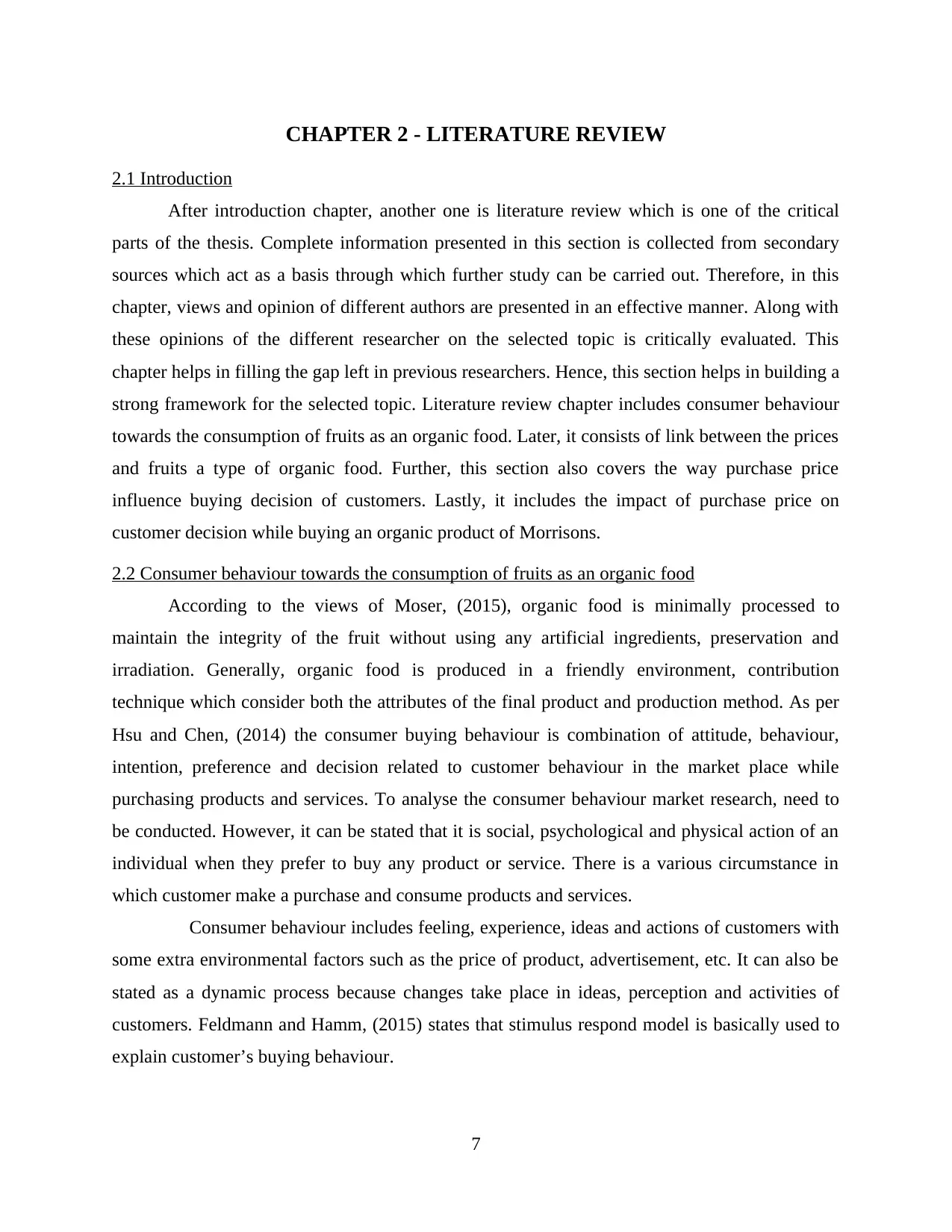
CHAPTER 2 - LITERATURE REVIEW
2.1 Introduction
After introduction chapter, another one is literature review which is one of the critical
parts of the thesis. Complete information presented in this section is collected from secondary
sources which act as a basis through which further study can be carried out. Therefore, in this
chapter, views and opinion of different authors are presented in an effective manner. Along with
these opinions of the different researcher on the selected topic is critically evaluated. This
chapter helps in filling the gap left in previous researchers. Hence, this section helps in building a
strong framework for the selected topic. Literature review chapter includes consumer behaviour
towards the consumption of fruits as an organic food. Later, it consists of link between the prices
and fruits a type of organic food. Further, this section also covers the way purchase price
influence buying decision of customers. Lastly, it includes the impact of purchase price on
customer decision while buying an organic product of Morrisons.
2.2 Consumer behaviour towards the consumption of fruits as an organic food
According to the views of Moser, (2015), organic food is minimally processed to
maintain the integrity of the fruit without using any artificial ingredients, preservation and
irradiation. Generally, organic food is produced in a friendly environment, contribution
technique which consider both the attributes of the final product and production method. As per
Hsu and Chen, (2014) the consumer buying behaviour is combination of attitude, behaviour,
intention, preference and decision related to customer behaviour in the market place while
purchasing products and services. To analyse the consumer behaviour market research, need to
be conducted. However, it can be stated that it is social, psychological and physical action of an
individual when they prefer to buy any product or service. There is a various circumstance in
which customer make a purchase and consume products and services.
Consumer behaviour includes feeling, experience, ideas and actions of customers with
some extra environmental factors such as the price of product, advertisement, etc. It can also be
stated as a dynamic process because changes take place in ideas, perception and activities of
customers. Feldmann and Hamm, (2015) states that stimulus respond model is basically used to
explain customer’s buying behaviour.
7
2.1 Introduction
After introduction chapter, another one is literature review which is one of the critical
parts of the thesis. Complete information presented in this section is collected from secondary
sources which act as a basis through which further study can be carried out. Therefore, in this
chapter, views and opinion of different authors are presented in an effective manner. Along with
these opinions of the different researcher on the selected topic is critically evaluated. This
chapter helps in filling the gap left in previous researchers. Hence, this section helps in building a
strong framework for the selected topic. Literature review chapter includes consumer behaviour
towards the consumption of fruits as an organic food. Later, it consists of link between the prices
and fruits a type of organic food. Further, this section also covers the way purchase price
influence buying decision of customers. Lastly, it includes the impact of purchase price on
customer decision while buying an organic product of Morrisons.
2.2 Consumer behaviour towards the consumption of fruits as an organic food
According to the views of Moser, (2015), organic food is minimally processed to
maintain the integrity of the fruit without using any artificial ingredients, preservation and
irradiation. Generally, organic food is produced in a friendly environment, contribution
technique which consider both the attributes of the final product and production method. As per
Hsu and Chen, (2014) the consumer buying behaviour is combination of attitude, behaviour,
intention, preference and decision related to customer behaviour in the market place while
purchasing products and services. To analyse the consumer behaviour market research, need to
be conducted. However, it can be stated that it is social, psychological and physical action of an
individual when they prefer to buy any product or service. There is a various circumstance in
which customer make a purchase and consume products and services.
Consumer behaviour includes feeling, experience, ideas and actions of customers with
some extra environmental factors such as the price of product, advertisement, etc. It can also be
stated as a dynamic process because changes take place in ideas, perception and activities of
customers. Feldmann and Hamm, (2015) states that stimulus respond model is basically used to
explain customer’s buying behaviour.
7
Paraphrase This Document
Need a fresh take? Get an instant paraphrase of this document with our AI Paraphraser
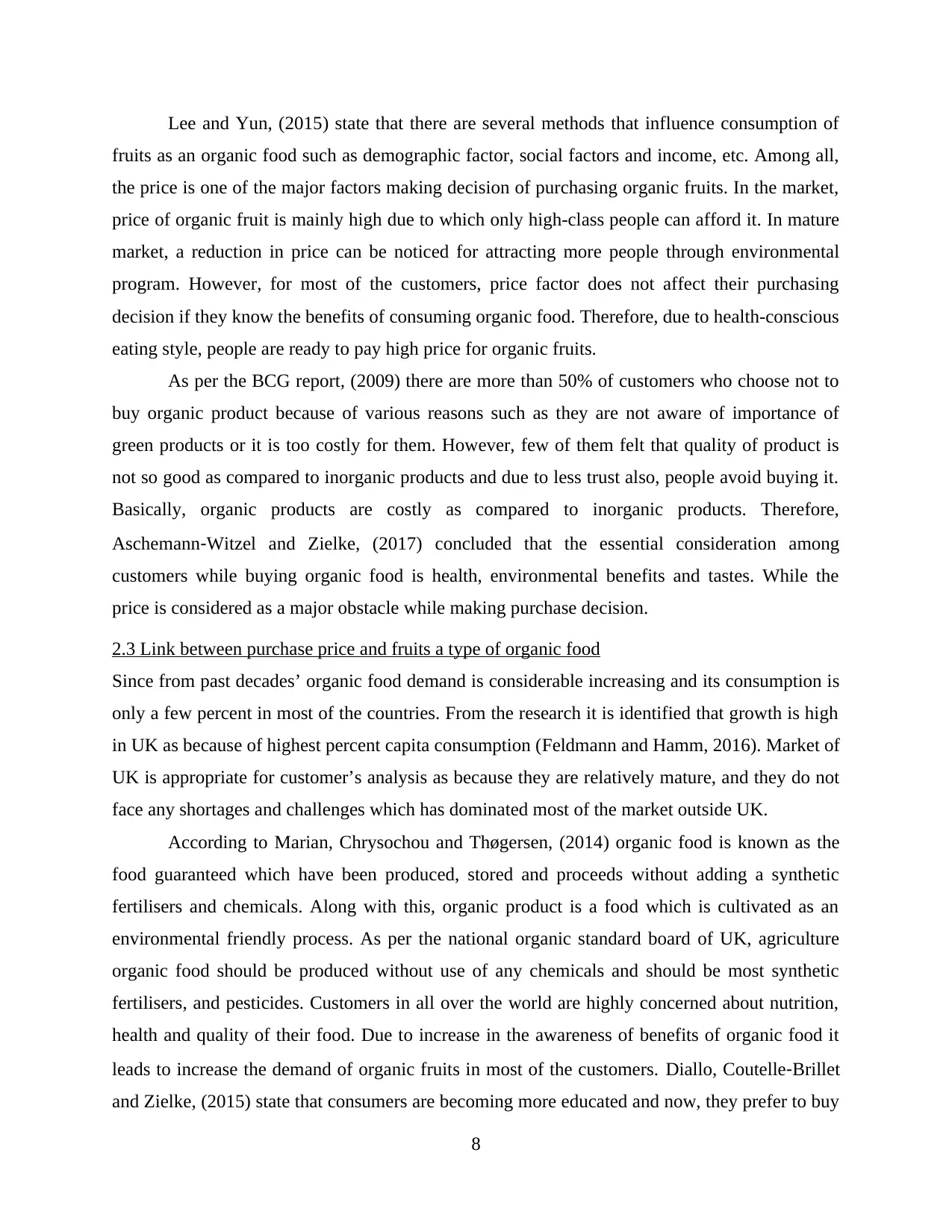
Lee and Yun, (2015) state that there are several methods that influence consumption of
fruits as an organic food such as demographic factor, social factors and income, etc. Among all,
the price is one of the major factors making decision of purchasing organic fruits. In the market,
price of organic fruit is mainly high due to which only high-class people can afford it. In mature
market, a reduction in price can be noticed for attracting more people through environmental
program. However, for most of the customers, price factor does not affect their purchasing
decision if they know the benefits of consuming organic food. Therefore, due to health-conscious
eating style, people are ready to pay high price for organic fruits.
As per the BCG report, (2009) there are more than 50% of customers who choose not to
buy organic product because of various reasons such as they are not aware of importance of
green products or it is too costly for them. However, few of them felt that quality of product is
not so good as compared to inorganic products and due to less trust also, people avoid buying it.
Basically, organic products are costly as compared to inorganic products. Therefore,
Aschemann‐Witzel and Zielke, (2017) concluded that the essential consideration among
customers while buying organic food is health, environmental benefits and tastes. While the
price is considered as a major obstacle while making purchase decision.
2.3 Link between purchase price and fruits a type of organic food
Since from past decades’ organic food demand is considerable increasing and its consumption is
only a few percent in most of the countries. From the research it is identified that growth is high
in UK as because of highest percent capita consumption (Feldmann and Hamm, 2016). Market of
UK is appropriate for customer’s analysis as because they are relatively mature, and they do not
face any shortages and challenges which has dominated most of the market outside UK.
According to Marian, Chrysochou and Thøgersen, (2014) organic food is known as the
food guaranteed which have been produced, stored and proceeds without adding a synthetic
fertilisers and chemicals. Along with this, organic product is a food which is cultivated as an
environmental friendly process. As per the national organic standard board of UK, agriculture
organic food should be produced without use of any chemicals and should be most synthetic
fertilisers, and pesticides. Customers in all over the world are highly concerned about nutrition,
health and quality of their food. Due to increase in the awareness of benefits of organic food it
leads to increase the demand of organic fruits in most of the customers. Diallo, Coutelle‐Brillet
and Zielke, (2015) state that consumers are becoming more educated and now, they prefer to buy
8
fruits as an organic food such as demographic factor, social factors and income, etc. Among all,
the price is one of the major factors making decision of purchasing organic fruits. In the market,
price of organic fruit is mainly high due to which only high-class people can afford it. In mature
market, a reduction in price can be noticed for attracting more people through environmental
program. However, for most of the customers, price factor does not affect their purchasing
decision if they know the benefits of consuming organic food. Therefore, due to health-conscious
eating style, people are ready to pay high price for organic fruits.
As per the BCG report, (2009) there are more than 50% of customers who choose not to
buy organic product because of various reasons such as they are not aware of importance of
green products or it is too costly for them. However, few of them felt that quality of product is
not so good as compared to inorganic products and due to less trust also, people avoid buying it.
Basically, organic products are costly as compared to inorganic products. Therefore,
Aschemann‐Witzel and Zielke, (2017) concluded that the essential consideration among
customers while buying organic food is health, environmental benefits and tastes. While the
price is considered as a major obstacle while making purchase decision.
2.3 Link between purchase price and fruits a type of organic food
Since from past decades’ organic food demand is considerable increasing and its consumption is
only a few percent in most of the countries. From the research it is identified that growth is high
in UK as because of highest percent capita consumption (Feldmann and Hamm, 2016). Market of
UK is appropriate for customer’s analysis as because they are relatively mature, and they do not
face any shortages and challenges which has dominated most of the market outside UK.
According to Marian, Chrysochou and Thøgersen, (2014) organic food is known as the
food guaranteed which have been produced, stored and proceeds without adding a synthetic
fertilisers and chemicals. Along with this, organic product is a food which is cultivated as an
environmental friendly process. As per the national organic standard board of UK, agriculture
organic food should be produced without use of any chemicals and should be most synthetic
fertilisers, and pesticides. Customers in all over the world are highly concerned about nutrition,
health and quality of their food. Due to increase in the awareness of benefits of organic food it
leads to increase the demand of organic fruits in most of the customers. Diallo, Coutelle‐Brillet
and Zielke, (2015) state that consumers are becoming more educated and now, they prefer to buy
8
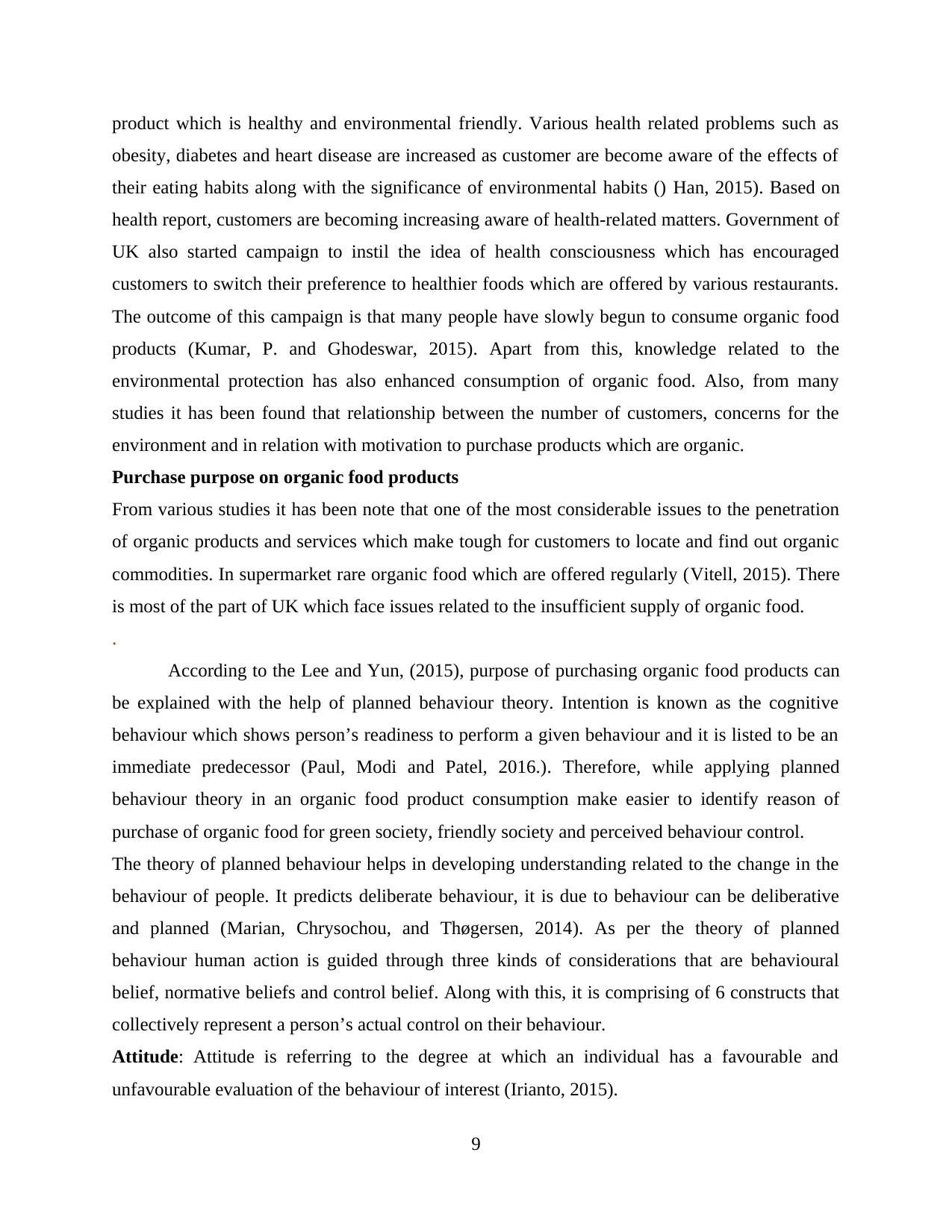
product which is healthy and environmental friendly. Various health related problems such as
obesity, diabetes and heart disease are increased as customer are become aware of the effects of
their eating habits along with the significance of environmental habits () Han, 2015). Based on
health report, customers are becoming increasing aware of health-related matters. Government of
UK also started campaign to instil the idea of health consciousness which has encouraged
customers to switch their preference to healthier foods which are offered by various restaurants.
The outcome of this campaign is that many people have slowly begun to consume organic food
products (Kumar, P. and Ghodeswar, 2015). Apart from this, knowledge related to the
environmental protection has also enhanced consumption of organic food. Also, from many
studies it has been found that relationship between the number of customers, concerns for the
environment and in relation with motivation to purchase products which are organic.
Purchase purpose on organic food products
From various studies it has been note that one of the most considerable issues to the penetration
of organic products and services which make tough for customers to locate and find out organic
commodities. In supermarket rare organic food which are offered regularly (Vitell, 2015). There
is most of the part of UK which face issues related to the insufficient supply of organic food.
.
According to the Lee and Yun, (2015), purpose of purchasing organic food products can
be explained with the help of planned behaviour theory. Intention is known as the cognitive
behaviour which shows person’s readiness to perform a given behaviour and it is listed to be an
immediate predecessor (Paul, Modi and Patel, 2016.). Therefore, while applying planned
behaviour theory in an organic food product consumption make easier to identify reason of
purchase of organic food for green society, friendly society and perceived behaviour control.
The theory of planned behaviour helps in developing understanding related to the change in the
behaviour of people. It predicts deliberate behaviour, it is due to behaviour can be deliberative
and planned (Marian, Chrysochou, and Thøgersen, 2014). As per the theory of planned
behaviour human action is guided through three kinds of considerations that are behavioural
belief, normative beliefs and control belief. Along with this, it is comprising of 6 constructs that
collectively represent a person’s actual control on their behaviour.
Attitude: Attitude is referring to the degree at which an individual has a favourable and
unfavourable evaluation of the behaviour of interest (Irianto, 2015).
9
obesity, diabetes and heart disease are increased as customer are become aware of the effects of
their eating habits along with the significance of environmental habits () Han, 2015). Based on
health report, customers are becoming increasing aware of health-related matters. Government of
UK also started campaign to instil the idea of health consciousness which has encouraged
customers to switch their preference to healthier foods which are offered by various restaurants.
The outcome of this campaign is that many people have slowly begun to consume organic food
products (Kumar, P. and Ghodeswar, 2015). Apart from this, knowledge related to the
environmental protection has also enhanced consumption of organic food. Also, from many
studies it has been found that relationship between the number of customers, concerns for the
environment and in relation with motivation to purchase products which are organic.
Purchase purpose on organic food products
From various studies it has been note that one of the most considerable issues to the penetration
of organic products and services which make tough for customers to locate and find out organic
commodities. In supermarket rare organic food which are offered regularly (Vitell, 2015). There
is most of the part of UK which face issues related to the insufficient supply of organic food.
.
According to the Lee and Yun, (2015), purpose of purchasing organic food products can
be explained with the help of planned behaviour theory. Intention is known as the cognitive
behaviour which shows person’s readiness to perform a given behaviour and it is listed to be an
immediate predecessor (Paul, Modi and Patel, 2016.). Therefore, while applying planned
behaviour theory in an organic food product consumption make easier to identify reason of
purchase of organic food for green society, friendly society and perceived behaviour control.
The theory of planned behaviour helps in developing understanding related to the change in the
behaviour of people. It predicts deliberate behaviour, it is due to behaviour can be deliberative
and planned (Marian, Chrysochou, and Thøgersen, 2014). As per the theory of planned
behaviour human action is guided through three kinds of considerations that are behavioural
belief, normative beliefs and control belief. Along with this, it is comprising of 6 constructs that
collectively represent a person’s actual control on their behaviour.
Attitude: Attitude is referring to the degree at which an individual has a favourable and
unfavourable evaluation of the behaviour of interest (Irianto, 2015).
9
⊘ This is a preview!⊘
Do you want full access?
Subscribe today to unlock all pages.

Trusted by 1+ million students worldwide
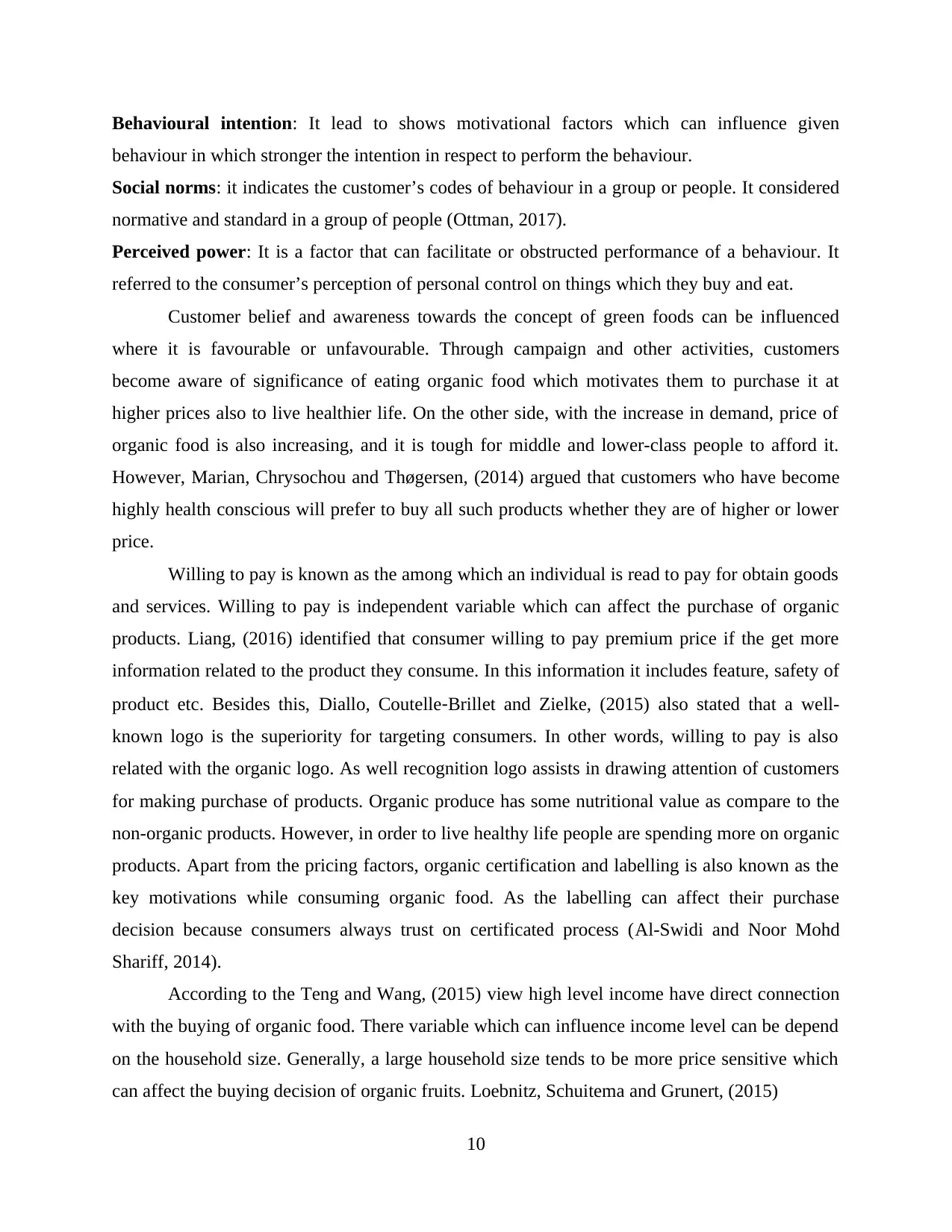
Behavioural intention: It lead to shows motivational factors which can influence given
behaviour in which stronger the intention in respect to perform the behaviour.
Social norms: it indicates the customer’s codes of behaviour in a group or people. It considered
normative and standard in a group of people (Ottman, 2017).
Perceived power: It is a factor that can facilitate or obstructed performance of a behaviour. It
referred to the consumer’s perception of personal control on things which they buy and eat.
Customer belief and awareness towards the concept of green foods can be influenced
where it is favourable or unfavourable. Through campaign and other activities, customers
become aware of significance of eating organic food which motivates them to purchase it at
higher prices also to live healthier life. On the other side, with the increase in demand, price of
organic food is also increasing, and it is tough for middle and lower-class people to afford it.
However, Marian, Chrysochou and Thøgersen, (2014) argued that customers who have become
highly health conscious will prefer to buy all such products whether they are of higher or lower
price.
Willing to pay is known as the among which an individual is read to pay for obtain goods
and services. Willing to pay is independent variable which can affect the purchase of organic
products. Liang, (2016) identified that consumer willing to pay premium price if the get more
information related to the product they consume. In this information it includes feature, safety of
product etc. Besides this, Diallo, Coutelle‐Brillet and Zielke, (2015) also stated that a well-
known logo is the superiority for targeting consumers. In other words, willing to pay is also
related with the organic logo. As well recognition logo assists in drawing attention of customers
for making purchase of products. Organic produce has some nutritional value as compare to the
non-organic products. However, in order to live healthy life people are spending more on organic
products. Apart from the pricing factors, organic certification and labelling is also known as the
key motivations while consuming organic food. As the labelling can affect their purchase
decision because consumers always trust on certificated process (Al-Swidi and Noor Mohd
Shariff, 2014).
According to the Teng and Wang, (2015) view high level income have direct connection
with the buying of organic food. There variable which can influence income level can be depend
on the household size. Generally, a large household size tends to be more price sensitive which
can affect the buying decision of organic fruits. Loebnitz, Schuitema and Grunert, (2015)
10
behaviour in which stronger the intention in respect to perform the behaviour.
Social norms: it indicates the customer’s codes of behaviour in a group or people. It considered
normative and standard in a group of people (Ottman, 2017).
Perceived power: It is a factor that can facilitate or obstructed performance of a behaviour. It
referred to the consumer’s perception of personal control on things which they buy and eat.
Customer belief and awareness towards the concept of green foods can be influenced
where it is favourable or unfavourable. Through campaign and other activities, customers
become aware of significance of eating organic food which motivates them to purchase it at
higher prices also to live healthier life. On the other side, with the increase in demand, price of
organic food is also increasing, and it is tough for middle and lower-class people to afford it.
However, Marian, Chrysochou and Thøgersen, (2014) argued that customers who have become
highly health conscious will prefer to buy all such products whether they are of higher or lower
price.
Willing to pay is known as the among which an individual is read to pay for obtain goods
and services. Willing to pay is independent variable which can affect the purchase of organic
products. Liang, (2016) identified that consumer willing to pay premium price if the get more
information related to the product they consume. In this information it includes feature, safety of
product etc. Besides this, Diallo, Coutelle‐Brillet and Zielke, (2015) also stated that a well-
known logo is the superiority for targeting consumers. In other words, willing to pay is also
related with the organic logo. As well recognition logo assists in drawing attention of customers
for making purchase of products. Organic produce has some nutritional value as compare to the
non-organic products. However, in order to live healthy life people are spending more on organic
products. Apart from the pricing factors, organic certification and labelling is also known as the
key motivations while consuming organic food. As the labelling can affect their purchase
decision because consumers always trust on certificated process (Al-Swidi and Noor Mohd
Shariff, 2014).
According to the Teng and Wang, (2015) view high level income have direct connection
with the buying of organic food. There variable which can influence income level can be depend
on the household size. Generally, a large household size tends to be more price sensitive which
can affect the buying decision of organic fruits. Loebnitz, Schuitema and Grunert, (2015)
10
Paraphrase This Document
Need a fresh take? Get an instant paraphrase of this document with our AI Paraphraser
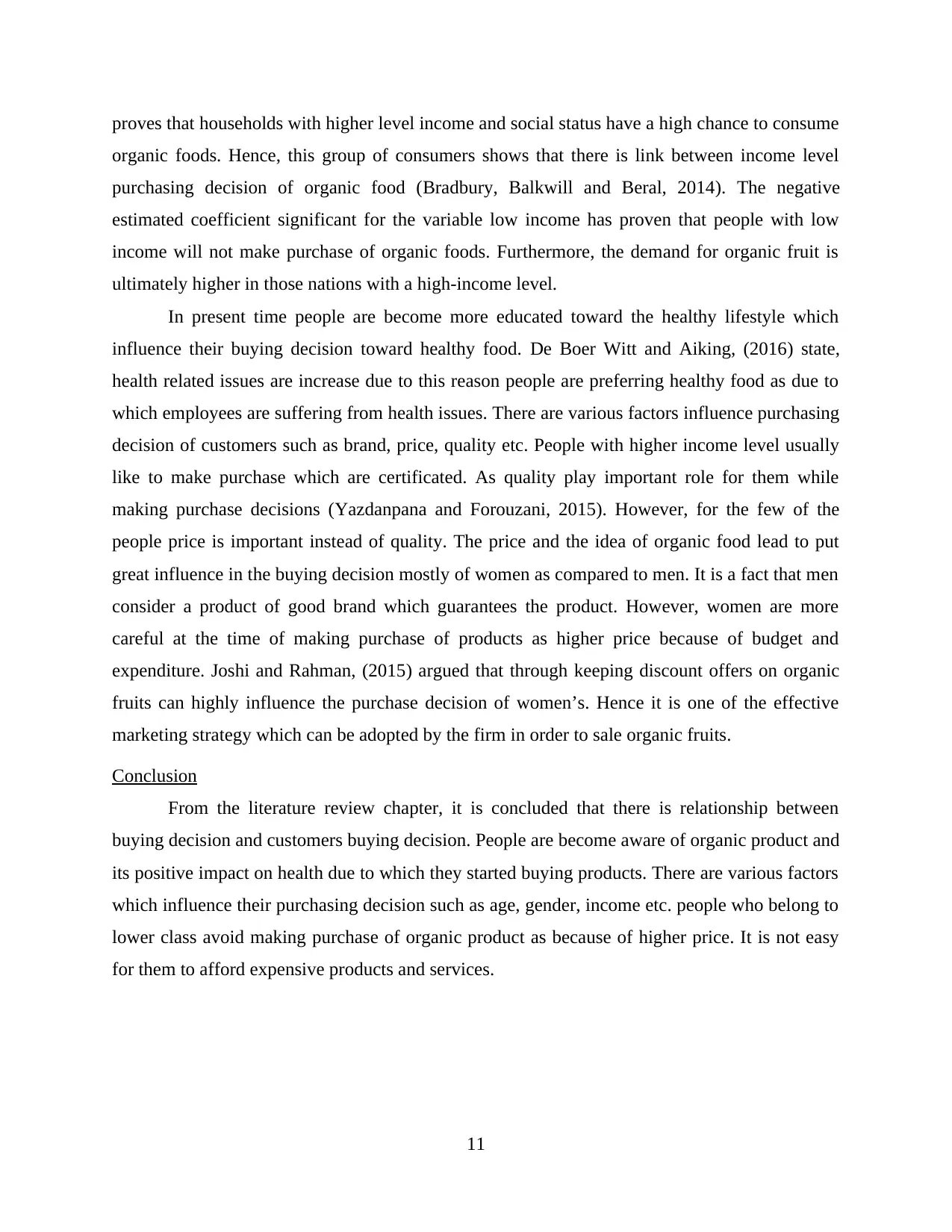
proves that households with higher level income and social status have a high chance to consume
organic foods. Hence, this group of consumers shows that there is link between income level
purchasing decision of organic food (Bradbury, Balkwill and Beral, 2014). The negative
estimated coefficient significant for the variable low income has proven that people with low
income will not make purchase of organic foods. Furthermore, the demand for organic fruit is
ultimately higher in those nations with a high-income level.
In present time people are become more educated toward the healthy lifestyle which
influence their buying decision toward healthy food. De Boer Witt and Aiking, (2016) state,
health related issues are increase due to this reason people are preferring healthy food as due to
which employees are suffering from health issues. There are various factors influence purchasing
decision of customers such as brand, price, quality etc. People with higher income level usually
like to make purchase which are certificated. As quality play important role for them while
making purchase decisions (Yazdanpana and Forouzani, 2015). However, for the few of the
people price is important instead of quality. The price and the idea of organic food lead to put
great influence in the buying decision mostly of women as compared to men. It is a fact that men
consider a product of good brand which guarantees the product. However, women are more
careful at the time of making purchase of products as higher price because of budget and
expenditure. Joshi and Rahman, (2015) argued that through keeping discount offers on organic
fruits can highly influence the purchase decision of women’s. Hence it is one of the effective
marketing strategy which can be adopted by the firm in order to sale organic fruits.
Conclusion
From the literature review chapter, it is concluded that there is relationship between
buying decision and customers buying decision. People are become aware of organic product and
its positive impact on health due to which they started buying products. There are various factors
which influence their purchasing decision such as age, gender, income etc. people who belong to
lower class avoid making purchase of organic product as because of higher price. It is not easy
for them to afford expensive products and services.
11
organic foods. Hence, this group of consumers shows that there is link between income level
purchasing decision of organic food (Bradbury, Balkwill and Beral, 2014). The negative
estimated coefficient significant for the variable low income has proven that people with low
income will not make purchase of organic foods. Furthermore, the demand for organic fruit is
ultimately higher in those nations with a high-income level.
In present time people are become more educated toward the healthy lifestyle which
influence their buying decision toward healthy food. De Boer Witt and Aiking, (2016) state,
health related issues are increase due to this reason people are preferring healthy food as due to
which employees are suffering from health issues. There are various factors influence purchasing
decision of customers such as brand, price, quality etc. People with higher income level usually
like to make purchase which are certificated. As quality play important role for them while
making purchase decisions (Yazdanpana and Forouzani, 2015). However, for the few of the
people price is important instead of quality. The price and the idea of organic food lead to put
great influence in the buying decision mostly of women as compared to men. It is a fact that men
consider a product of good brand which guarantees the product. However, women are more
careful at the time of making purchase of products as higher price because of budget and
expenditure. Joshi and Rahman, (2015) argued that through keeping discount offers on organic
fruits can highly influence the purchase decision of women’s. Hence it is one of the effective
marketing strategy which can be adopted by the firm in order to sale organic fruits.
Conclusion
From the literature review chapter, it is concluded that there is relationship between
buying decision and customers buying decision. People are become aware of organic product and
its positive impact on health due to which they started buying products. There are various factors
which influence their purchasing decision such as age, gender, income etc. people who belong to
lower class avoid making purchase of organic product as because of higher price. It is not easy
for them to afford expensive products and services.
11
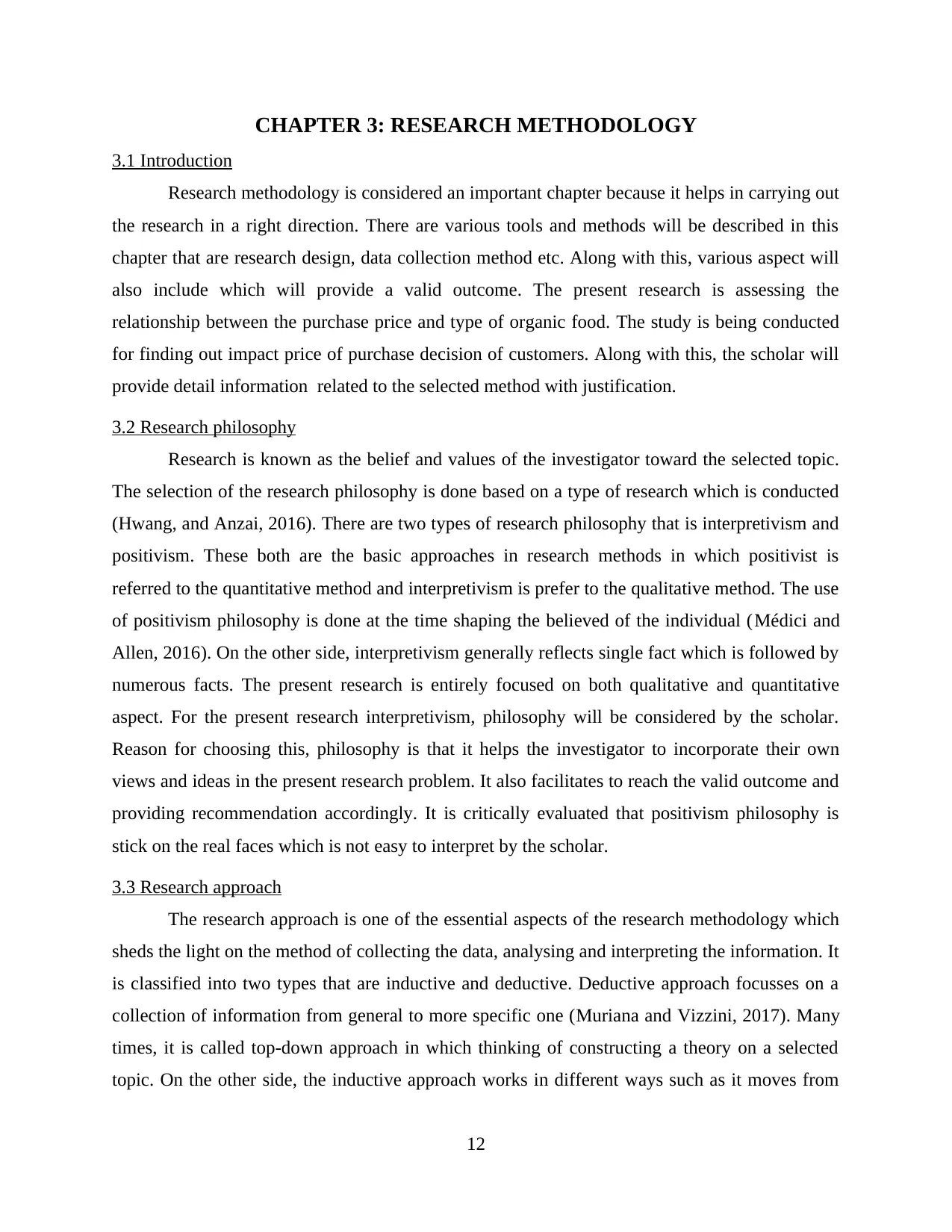
CHAPTER 3: RESEARCH METHODOLOGY
3.1 Introduction
Research methodology is considered an important chapter because it helps in carrying out
the research in a right direction. There are various tools and methods will be described in this
chapter that are research design, data collection method etc. Along with this, various aspect will
also include which will provide a valid outcome. The present research is assessing the
relationship between the purchase price and type of organic food. The study is being conducted
for finding out impact price of purchase decision of customers. Along with this, the scholar will
provide detail information related to the selected method with justification.
3.2 Research philosophy
Research is known as the belief and values of the investigator toward the selected topic.
The selection of the research philosophy is done based on a type of research which is conducted
(Hwang, and Anzai, 2016). There are two types of research philosophy that is interpretivism and
positivism. These both are the basic approaches in research methods in which positivist is
referred to the quantitative method and interpretivism is prefer to the qualitative method. The use
of positivism philosophy is done at the time shaping the believed of the individual (Médici and
Allen, 2016). On the other side, interpretivism generally reflects single fact which is followed by
numerous facts. The present research is entirely focused on both qualitative and quantitative
aspect. For the present research interpretivism, philosophy will be considered by the scholar.
Reason for choosing this, philosophy is that it helps the investigator to incorporate their own
views and ideas in the present research problem. It also facilitates to reach the valid outcome and
providing recommendation accordingly. It is critically evaluated that positivism philosophy is
stick on the real faces which is not easy to interpret by the scholar.
3.3 Research approach
The research approach is one of the essential aspects of the research methodology which
sheds the light on the method of collecting the data, analysing and interpreting the information. It
is classified into two types that are inductive and deductive. Deductive approach focusses on a
collection of information from general to more specific one (Muriana and Vizzini, 2017). Many
times, it is called top-down approach in which thinking of constructing a theory on a selected
topic. On the other side, the inductive approach works in different ways such as it moves from
12
3.1 Introduction
Research methodology is considered an important chapter because it helps in carrying out
the research in a right direction. There are various tools and methods will be described in this
chapter that are research design, data collection method etc. Along with this, various aspect will
also include which will provide a valid outcome. The present research is assessing the
relationship between the purchase price and type of organic food. The study is being conducted
for finding out impact price of purchase decision of customers. Along with this, the scholar will
provide detail information related to the selected method with justification.
3.2 Research philosophy
Research is known as the belief and values of the investigator toward the selected topic.
The selection of the research philosophy is done based on a type of research which is conducted
(Hwang, and Anzai, 2016). There are two types of research philosophy that is interpretivism and
positivism. These both are the basic approaches in research methods in which positivist is
referred to the quantitative method and interpretivism is prefer to the qualitative method. The use
of positivism philosophy is done at the time shaping the believed of the individual (Médici and
Allen, 2016). On the other side, interpretivism generally reflects single fact which is followed by
numerous facts. The present research is entirely focused on both qualitative and quantitative
aspect. For the present research interpretivism, philosophy will be considered by the scholar.
Reason for choosing this, philosophy is that it helps the investigator to incorporate their own
views and ideas in the present research problem. It also facilitates to reach the valid outcome and
providing recommendation accordingly. It is critically evaluated that positivism philosophy is
stick on the real faces which is not easy to interpret by the scholar.
3.3 Research approach
The research approach is one of the essential aspects of the research methodology which
sheds the light on the method of collecting the data, analysing and interpreting the information. It
is classified into two types that are inductive and deductive. Deductive approach focusses on a
collection of information from general to more specific one (Muriana and Vizzini, 2017). Many
times, it is called top-down approach in which thinking of constructing a theory on a selected
topic. On the other side, the inductive approach works in different ways such as it moves from
12
⊘ This is a preview!⊘
Do you want full access?
Subscribe today to unlock all pages.

Trusted by 1+ million students worldwide
1 out of 41